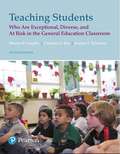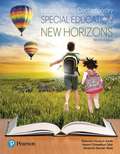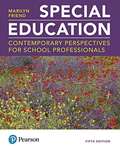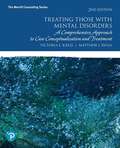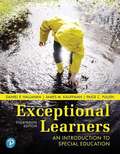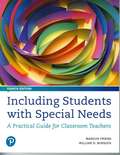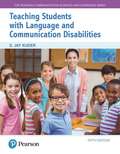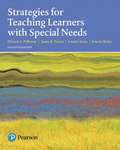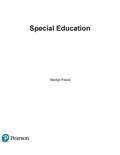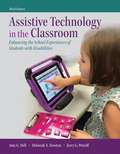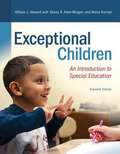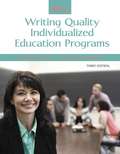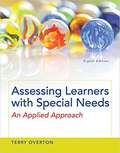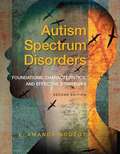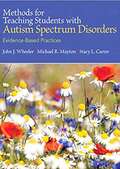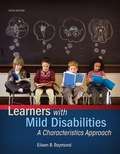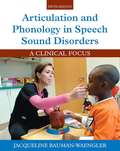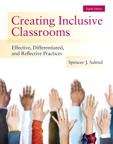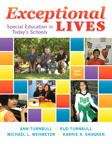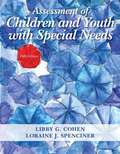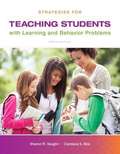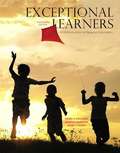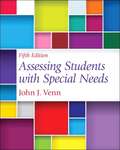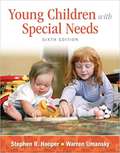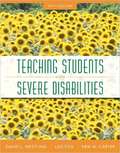- Table View
- List View
Teaching Students who are Exceptional, Diverse, and at Risk in the General Education Classroom
by Sharon Vaughn Candace Bos Jeanne SchummTeaching Students Who Are Exceptional, Diverse, and at Risk in the General Education Classroom is the ideal guide for classroom teachers who identify students with special needs as both their greatest challenges and often their greatest rewards. With its numerous learning activities and sample lessons—plus stories from teachers, students, and parents—it strongly focuses on applying practical, proven strategies for effective teaching and learning. The authors go above and beyond simply describing curriculum adaptations by providing step-by-step procedures for implementing those adaptations in the actual classroom. After reading this book, pre- and in-service teachers alike are armed with the tools and confidence they need to effectively meet their students’ diverse academic, behavioral, and social needs.
Introduction to Contemporary Special Education: New Horizons
by Deborah Smith Naomi Tyler Kimberly SkowIntroduction to Contemporary Special Education: New Horizons presents an introduction to the professional practices, trends, and research that define contemporary special education while also conveying the diversity and excitement of this changing field.
Special Education: Contemporary Perspectives For School Professionals
by Marilyn FriendReal teachers, real families and students, and real classrooms bring the field of Special Education to life. Special Education: Contemporary Perspectives for School Professionals, Fifth Edition, provides a multi-dimensional view of the field of special education. The most current information and research available provides structure and predictability for novices to the field of special education in today’s educational world. Because special education is made up of real children and real professionals, the author helps to put a “face” on the field to enliven and authenticate the information. Each chapter features stories of individuals with disabilities from the parents of children with disabilities and from professionals who work in the field. Readers of this truly exceptional text will come away with the best understanding of the expectations for educators and students, and learn how critical concepts translate into educational practices.
Treating Those with Mental Disorders: A Comprehensive Approach to Case Conceptualization and Treatment
by Victoria E. Kress Matthew J. PayloThis book offers students and new counselors specific treatment planning, implementation, and intervention strategies in addition to background information on clinical issues and DSM-5 diagnoses and interventions. A strength-based framework for conceptualizing and treating clients guides students through the process of selecting and implementing treatments. Real-life examples illustrate how critical counseling concepts and approaches are applied in actual practice. Updated with current, evidence-based treatment techniques, a new chapter on culture and ethics, and even more applications and examples, this highly practical resource empowers counselors to thoughtfully and deliberately help their clients tackle complex issues and difficulties.
Exceptional Learners: An Introduction to Special Education
by Daniel P. Hallahan James M. Kauffman Paige C. PullenAn up-to-date introduction to the characteristics of exceptional learners and their education <P><P>Exceptional Learners: An Introduction to Special Education focuses on exceptional learners and classroom practices, as well as the psychological, sociological, and medical aspects of disabilities and giftedness. <P><P>Based on the authors’ premise that professionals working with exceptional learners need to develop not only a solid base of knowledge, but also a healthy attitude toward their work and the people whom they serve, this book is designed to reach the heart as well as the mind. It asks both general and special educators to challenge themselves to acquire a solid understanding of current theory, research, and practice in special education, and to develop an ever more sensitive understanding of exceptional learners and their families. <P><P>The 14th Edition includes the new definitions of Specific Learning Disorder, Attention Deficit Hyperactivity Disorder (ADHD), Emotional and Behavioral Disorders, and Autism Spectrum Disorders (ASD) from the American Psychiatric Association’s DSM-5, along with expanded coverage of topics like Universal Design for Learning, Multi-Tiered System of Supports (MTSS), and Positive Behavioral Interventions and Supports (PBIS).
Including Students With Special Needs: A Practical Guide For Classroom Teachers
by Marilyn Friend William D. BursuckIncluding Students with Special Needs provides readers with a firm grounding in critical special education concepts, an understanding of the professionals who support students with special needs, knowledge of the procedures that should be followed to ensure that students with special needs rights are upheld, and a wealth of research-based strategies and interventions that we know help foster student success. Filled with realistic school scenarios, additional vignettes of children with disabilities and other special needs, new information on multi-tiered systems of support, and over 400 new reference citations, the 8th Edition introduces pre-service teachers to the complexities, realities, and rewards of being a professional educator today.
Teaching Students With Language And Communication Disabilities
by S. KuderDesigned for special education teachers, this text contains numerous case studies illustrating the impact of language disorders on students and on classrooms. The book includes descriptions of language disabilities by category of disability, and contains activities for group or individual projects.
Strategies For Teaching Learners With Special Needs
by Edward A. Polloway James R. Patton Loretta Serna Jenevie W. BaileyThis widely popular text combines the work of authoritative experts to present the most comprehensive exploration of how to teach students with mild/high incidence disabilities, including learning disabilities, mild intellectual disabilities, emotional and behavioral disorders, and students experiencing learning problems in the general education classroom. With a focus on effective instructional practices that can be used in diverse, inclusive educational environments, and balanced coverage of elementary and secondary strategies, it presents the latest changes in the field and ensures currency and applicability to contemporary education for preservice and in-service teachers. <p><p> In addition to two chapters on general curriculum and instruction information (one new to this edition), the book also includes chapters on classroom and behavioral management, oral language instruction, reading, writing, mathematics, social studies, science, study skills, social and self-determination skills, applied academics, and career and transition considerations. The Enhanced Pearson eText features embedded videos, check your understanding quizzes, and interactive learning modules.
Special Education: Contemporary Perspectives For School Professionals
by Marilyn Penovich FriendSpecial Education Contemporary Perspectives for School Professionals 5th Edition
Assistive Technology in the Classroom: Enhancing the School Experiences of Students with Disabilities (Third Edition)
by Amy G. Dell Deborah A. Newton Jerry G. PetroffWith an emphasis on the integration of assistive technology into the curriculum, this text focuses on how assistive technology can be used in schools to enhance the teaching and learning of students with disabilities. This link between technology and teaching and learning drives the book's organization as well as its content. It is organized by school-related tasks that students must perform on a daily basis to be successful -- reading, writing, practicing academic skills, and communicating with their teachers and peers – and presents descriptions of technology-based solutions to the obstacles students with disabilities face in completing these tasks. Since being able to access computers is one major barrier, the text features a section on making computers accessible to students with a wide range of disabilities. A companion web site offers up-to-date information on product names, vendors, web site addresses, and other time-sensitive material.
Exceptional Children: An Introduction To Special Education (Eleventh Edition)
by William L. HewardThis package includes the REVEL(tm) access card and loose-leaf version. REVEL is Pearson's newest way of delivering our respected content. Fully digital and highly engaging, REVEL replaces the textbook and gives students everything they need for the course. Informed by extensive research on how people read, think, and learn, REVEL is an interactive learning environment that enables students to read, practice, and study in one continuous experience--for less than the cost of a traditional textbook. An informative, accessible, and interesting introduction to the ongoing story of special education. Special education is an ongoing story of people-of exceptional children, of the families of children with special needs, and of the teachers who work with them. Exceptional Children: An Introduction to Special Education focuses on 15 experienced teachers to give readers first-person insight into this diverse field. It also details, step-by-step, how special educators use highly effective, research-based practices to promote student achievement in their classrooms. The Eleventh Edition includes new information that reflects the current professional practices, trends, and research that define the exciting and ever-evolving field of special education. NOTE: Before purchasing, check with your instructor to ensure you select the correct ISBN. Several versions of Pearson's products exist for each title*, and registrations are not transferable. In addition to the access card included in this package, you will need a course invite link, provided by your instructor, to register for and use REVEL. Used books, rentals, and purchases made outside of Pearson If purchasing or renting from companies other than Pearson, the access code for REVEL may not be included, may be incorrect, or may be previously redeemed. Check with the seller before completing your purchase. 0134027116 / 9780134027111 REVEL for Exceptional Children: An Introduction to Special Education with Loose-Leaf Version Package consists of: 013420140X / 9780134201405 Exceptional Children: An Introduction to Special Education, Loose-Leaf Version 0134303288 / 9780134303284 REVEL for Exceptional Children: An Introduction to Special Education -- Access Card * REVEL features such as embedded videos, exercises, and quizzes are only available in the REVEL format. They are not available in third-party eTexts or downloads.
IEPs: Writing Quality Individualized Education Programs
by Gordon S. Gibb Tina Taylor DychesThis book is a practical help for mastering the process of developing and writing quality individualized education programs (IEPs). This best-selling, essential resource includes step-by-step instructions backed by examples, practice, and feedback to help users gain the critical skills and knowledge they need to write effective IEPs, meet the standards of IDEA, and ultimately plan instruction for students with disabilities. Guide to Writing Quality Individualized Education Programs includes an easy-to-understand summary of IDEA 2004; a workable organization of the IEP process into seven manageable steps; explanations, modeling, practice, and feedback for mastering each step of the process; and a brief procedural summary at the end of each step. The new edition features the latest information and references to help readers as they work through the process in such areas as recognizing and referencing IEPs for a variety of disabilities, genders, and grade levels; basing IEPs on required state or core curricula; phrasing goals that address standards, while also meeting the needs of students performing below-grade level; understanding the role of Response to Intervention in addressing needs in the general classroom; and learning how the No Child Left Behind Act affects high-stakes testing for students with disabilities. Ideal for teacher candidates, in-service educators, parents and other IEP team members, the guide can be used for whole group instruction, out-of-class assignments, or as independent study.
Assessing Learners With Special Needs: An Applied Approach
by Terry OvertonAssessing Learners with Special Needs: An Applied Approach, 8/e provides readers with a practical, step-by-step approach to learning about the complex procedures of the assessment process. This new edition provides a new presentation format and a new format for assessing student mastery of material through interactive learning activities.
Autism Spectrum Disorders: Foundations, Characteristics, and Effective Strategies
by E. Boutot Brenda MylesAutism Spectrum Disorders provides teachers of students with Autism Spectrum Disorder (ASD) or other developmental disabilities with important background information, historical context, etiological underpinnings, and characteristics of ASD that may impact learning. Written in an easy-to-follow format, the book focuses on evidence-based practices and approaches that have empirical bases for use. The book identifies current trends in research and practice and includes special Research, Diversity, and Trends and Issues boxes to clarify the concepts. Each chapter begins with real life scenarios depicting key information and concepts found in that chapter and include key terms, chapter objectives, end-of-chapter questions, and web resources to enhance learning and expand beyond the text. Significant changes to this edition include a chapter focusing on play, a chapter on motor development, and a chapter on sexuality. Updates and changes to the functional academics, functional life skills, environmental supports, and transition chapters add currency and further clarification to those topics. Throughout, the book focuses on real world practice that promotes lifespan success.
Methods for Teaching Students With Autism Spectrum Disorders: Evidence-Based Practices
by Stacy L. Carter John J. Wheeler Michael R. MaytonMethods for Teaching Students with Autism Spectrum Disorders is the most comprehensive text available, aimed at helping pre-service and in-service teachers and related service professionals understand the importance of evidence-based practices in the education of learners with Autism Spectrum Disorders (ASD) from a family and longitudinal learning perspective. <p><p>With its emphasis on the theme of family and professional partnerships and collaboration and consultation, the book includes learning aids such as suggested print and web-based resources, graphic organizers, and points for reflection; child and family vignettes, “Consider This” features, and examples of exemplary programs and practices; and the most up-to-date information and latest trends in the field.
Learners with Mild Disabilities: A Characteristics Approach
by Eileen B. RaymondLearners with Mild Disabilities: A Characteristics Approach focuses on high-prevalence disorders affecting school learners today, including mild intellectual disabilities, learning disabilities, emotional/behavioral disorders, ADHD, autism spectrum disorders, and communication disorders, as well as on low incidence conditions that may manifest in the milder range, for example sensory, physical, health, or TBI. The author lays the foundation for addressing the needs of special learners and then focuses on learners from the perspective of alternative non-categorical frameworks. She describes students with disabilities and related conditions with respect to a variety of individual strengths and needs, considering their cognitive, language, academic learning, and social/emotional characteristics. Readers see how to apply these conceptual frameworks by analyzing a number of vignettes and extended case studies based on the experiences of real children and teachers. Designed as a primary text for use in undergraduate and graduate courses addressing the characteristics of learners with high prevalence or milder levels of disability, the text is also useful for the first specialized course in a special education program. It supports programs in inclusive education or the growing area of generic special education. The Enhanced Pearson eText features embedded video.
Articulation and Phonology In Speech Sound Disorders: A Clinical Focus
by Jacqueline Bauman-WaenglerThis comprehensive book ties strong academic foundations directly to their clinical application for speech/language therapists working with speech sound disorders. Each chapter presents tools to help readers bridge the gap between theoretical issues and clinical applications by presenting Clinical Applications, Clinical Exercises, Case Studies, and a section called Think Critically, which asks students to further apply specific clinical concepts. Test Yourself multiple choice questions appear at the end of each chapter and are ideal for review and assessment of the knowledge presented in the chapters, and Further Readings allow readers to continue to expand their knowledge. The new Fifth Edition of Articulation and Phonology in Speech Sound Disorders reflects the current use of the term "speech sound disorder," an umbrella term for what was previously noted as articulation- and phonemic-based disorders.
Creating Inclusive Classrooms: Effective, Differentiated, and Reflective Practices (Eighth Edition)
by Spencer J. SalendCreating effective inclusive classrooms means understanding the role of education in a democratic society and federal legislation, as well as aligning your instruction with national and state standards. But the practical, up-to-date and digital eighth edition of Creating Inclusive Classrooms: Effective, Differentiated and Reflective Practices recognizes that it means more than that. It means using current research related to effective practices in curriculum, instruction, technology, assessment, classroom management, collaboration, and family involvement to foster the learning of all of your students. It means being an evidence-based and reflective educator who continually collects and analyzes evidence to document and enhance the effectiveness of your professional practices, and who thinks critically about your own values and beliefs so you can better differentiate your instruction and promote the learning of all of your students. It means being sensitive and responsive to diversity and individual differences, and collaborating with your students and their families and other educators to create the most successful educational experience for all of your students.
Exceptional Lives: Special Education In Today's Schools
by Ann Turnbull Rud Turnbull Michael Wehmeyer Karrie ShogrenExceptional Lives: Special Education in Today's Schools pairs real-life stories about children, their families, and their educators with the most recent evidence-based research on inclusion of students with disabilities in the least restrictive environment. Updated real-world vignettes, first-person My Voice features, and new videos immerse readers in the lives of exceptional individuals. With its focus on real students, stories, and solutions, Exceptional Lives gives readers a comprehensive view of the rewards, challenges, and triumphs involved in special education today.
Assessment of Children and Youth with Special Needs
by Libby G. Cohen Loraine J. SpencinerThis highly respected text focuses on current assessment issues and procedures that every special educator needs to know. The author's integrated approach emphasizes in-class assessment approaches as well as more formal measures and instruments. Throughout they provide numerous practical examples of how the techniques and procedures can be used in the classroom. Included are practical, ready-to-used materials integrated within instruction delivery methods; relevant case studies; and examinations of current assessment topics in every chapter.
Strategies for Teaching Students with Learning and Behavior Problems,Ninth Edition
by Sharon Vaughn Candace S. BosFor courses in Mid/Moderate Disabilities Methods (Special Education); Methods for Students with Learning and Behavior Problems (Special Education) This bestselling text focuses on presenting the ideal content for preparing teachers to meet the needs of elementary and secondary students with learning and behavior problems in a variety of settings. Streamlined in the previous edition to provide more hands on applications and classroom strategies than any other methods text on the market, this new Ninth Edition presents fresh ideas and information on best practices through the use of embedded video clips, web links, and step-by-step instructional strategies. Featured in this edition are a new emphasis on and integration of the Common Core State Standards (CCSS) throughout; updated coverage of RtI; a new emphasis on higher level thinking, including reading comprehension and complex texts as well as problem solving, fractions, and algebra; increased focus on classroom management and positive behavior support; and updated and enhanced key research, practice opportunities, and strategies throughout.
Exceptional Learners: An Introduction to Special Education (Thirteenth Edition)
by Daniel P. Hallahan James M. Kauffman Paige C. PullenIn Exceptional Learners by Hallahan, Kauffman, and Pullen, readers get an up-to-date introduction to the characteristics of exceptional learners and their education that emphasizes classroom practices, as well as the psychological, sociological, and medical aspects of disabilities and giftedness. Based on the author’s premise that professionals working with exceptional learners need to develop not only a solid base of knowledge, but also a healthy attitude toward their work and the people whom they serve, this book is designed to reach the heart as well as the mind. It asks both general and special educators to challenge themselves to acquire a solid understanding of current theory, research, and practice in special education, and to develop an ever more sensitive understanding of exceptional learners and their families.
Assessing Students With Special Needs
by John VennA practical, applied approach to testing and measurement focusing on how teachers can use evaluation as part of instruction <p><p> Well respected for its practical, applied approach to testing and measurement, the Fifth Edition of Venn’s Assessing Students with Special Needs continues to focus on how teachers can use evaluation as part of instruction. In this revision the author highlights what teachers really need to know in order to include assessment in the teaching and learning process. Coverage includes all of the core information expected in an assessment text and yet goes far beyond the basics to address multicultural considerations, curriculum-based measurement, curriculum-based assessment, and the most current versions of the most widely used tests. <p> This popular text shows educators how assessment is much more than giving a test to a child by clearly illustrating why it is an essential tool for teachers as they help children achieve, learn, develop, grow, progress, and succeed. With this resource as a guide, teachers are prepared to help all students by showing why, when, and how to use the complete range of assessment methods, tools, techniques, and procedures.
Young Children with Special Needs
by Warren Umansky Stephen HooperUnderstand typical child development from birth to five and how children with special needs develop differently. Explore six core developmental domains including: gross motor, fine motor and oral motor development, self-care, cognitive development, communication development, and social and emotional development. Read contributions from a variety of experts, each one explaining the latest early intervention strategies within their area of specialty. Learn the process of assessment and intervention and develop universal skills that best support children and their families. Study cases and discuss successful intervention and assessment methods.
Teaching Students with Severe Disabilities
by Erik Carter David Westling Lise FoxProvides comprehensive coverage of the major issues pertinent to teaching students with severe disabilities―highly useful information presented in way readers can readily understand and apply. KEY TOPICS: Students with severe disabilities: definitions, descriptions, characteristics, and potential; philosophies and practices for teaching students with severe disabilities; collaboration among professionals and paraprofessionals; parents, families, and cultural issues; planning instructional programs for students with severe disabilities; determining instructional goals for students with severe disabilities; teaching students to acquire new skills; teaching skills for generalization and maintenance; evaluating student progress; creating inclusive educational environments; teaching communication skills; providing behavior support to improve challenging behavior; managing sensory and motor systems; providing support for health and medical needs; teaching personal care skills; fostering friendships and recreational involvement; teaching academic skills; teaching community and domestic skills; using assistive technology; meeting the needs of young children; transitioning to adulthood. MARKET: For educators involved in teaching students with severe learning disabilities or moderate and severe.
